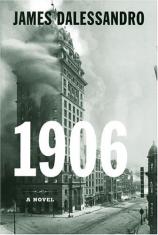Reading Group Guide
Discussion Questions
1906: A Novel

1. How did you feel about Annalisa Passarelli as the narrator of 1906? Women at the turn of the century were in a great period of transformation. Did you identify with her, feel that she represented that spirit?
2. Were you shocked to learn about the rampant corruption in San Francisco? About the treatment of Chinese girls and the Shanghaiing of unwilling sailors? What surprised you the most?
3. How did you feel about the history of San Francisco and the disaster? Were you surprised to read the methods employed by the politicians and the army to try to stop the fire? About the shooting of suspected looters?
4. Fans of the book have debated their favorite characters. Was there any that particularly resonated with you?
5. Historical novels often blend fiction and real life characters: at the end of the novel, Mr. Dalessandro explains who was who. Did you find the interaction --- and the guide to this --- a satisfactory effort?
6. The "Cain and Abel" elements of the Christian Fallon - Hunter Fallon relationship is a classic device for fiction writers, two brothers who are both at war and in harmony with each other. Did this remind you of any other pair of brothers and keep you engaged?
7. There is an old adage that "good bad guys" can make or break a good tale, as did Hannibal Lecter in "Silence of the Lambs." Mr. Dalessandro employed a wide array of inter-connected villains: Boss Abe Ruef, Mayor Eugene Schmitz, General Frederick Funston, Shanghai Kelly. How did they figure into the story, and did they represent the San Francisco that the author tried to convey?
8. Sometimes smaller, secondary characters can steal the story as well. What did Enrico Caruso represent to 1906? And what of Kaitlin Staley, the runaway Kansas farm girl, and her father, Sheriff Lincoln Staley. A legendary San Francisco character, Emperor Norton, was used as "Emperor Milton", and has but one real appearance, when he rescues Kaitlin: did you feel this spoke to San Francisco's love of zany characters?
9. The author wrote a "disaster novel" differently from others: he spent half the book building up the city of San Francisco and its broad cast of characters. Did you find that engaging, and did he accomplish his (or Annalisa Passarelli's) mandate to let you know what was, so that you could better gauge what was lost?
10. The author employed a unique device: having Annalisa as the narrator, relating her own personal experiences, then painting portraits of the activities of others, which she says in the prologue she created from things that were told to her, from letters from both the living and dead, stating that no one point of view could tell "this great tale." She also states it was a device she learned from her heroine, the pioneering journalist Nellie Bly. Did this work for you and hold your attention
11. One of the challenges of historical novels -- and the joy when it works -- is to be transported to another time and place, to hear and see and feel it like we were there. If 1906 did that for you, was there anything in particular that you found most effective?
12. Historic novels often try to tell us something big, offer us a theme, something that we may be losing in modern life. Was there anything that resonates with you.
13. Was there anything that you read that reminds you of current life, of lessons we have not learned, that make you wonder if we are really changing or growing as a society, or in fact slipping backward?
1906: A Novel
- Publication Date: March 3, 2005
- Paperback: 368 pages
- Publisher: Chronicle Books
- ISBN-10: 0811849414
- ISBN-13: 9780811849418






